With email marketing’s consistent returns, starting an email marketing program is an easy decision to make. The path to scale your small business’s email marketing program isn’t quite as clear. Email marketing programs enable businesses of all sizes to reap the benefits of email marketing without overcomplicating the process. Learn how to set up your email marketing program with a solid foundation built for growth in this step-by-step guide.
You’ve probably heard the phrase, “Do things that don’t scale.”
This advice refers to the personal connections and hands-on contacts startups and small businesses employ to gain traction and get their businesses off the ground.
But the phrase reveals the strategy’s weakness–placing your growth in the hands of individual actions doesn’t scale.
What happens when your team can no longer contact every prospect individually? How do you keep your small business top of mind and communicate its latest news or promotions as your customer base grows?
Email marketing using your company’s diligently gathered list of subscribers is an affordable, effective solution.
Even though email marketing delivers content to your subscribers, it is part of the inbound or attraction marketing family of business growth strategies.
Email marketing allows you to deliver relevant, value-adding and engaging content straight to people who have signaled their interest in your brand.
Setting up your business’s email marketing program prepares you to take your marketing communications to the next level and position your brand for sustainable, scalable growth.
In this article, I’ll explain how your small business can set up its email marketing operations to maintain strong customer relationships at scale.
You’ll discover
- Why email marketing is important for businesses of all sizes;
- The tools, software and services that businesses use to build and support their email marketing programs; and
- How to set up your email marketing operations to maximize your SMB’s performance.
Are you ready to build an email marketing powerhouse to fuel your brand’s growth? Let’s launch!
Why should SMBs set up email marketing operations?
Enterprise businesses have long realized the benefits of integrated, high-performance email marketing. These brands connect data across properties and create sophisticated automations to reach their audience across channels. A comprehensive email marketing program leverages automation and analytics to maintain and optimize brand communications with email subscribers and boost email-generated revenue.
When all the components of an email marketing operation successfully fall into place, synergies and efficiencies emerge.
The whole becomes greater than the sum of the parts.
These rewards aren’t available only to enterprise-size organizations, though. Businesses of all sizes can reap benefits from setting up their permission email marketing operations for efficiency and scalability–and they don’t have to do it on their own.
Putting together a new email marketing program or developing a program that will scale with your business is a little like building a piece of furniture.
IKEA is famous worldwide for its kits that make furniture assembly relatively painless–if not always easy. The company enables people to scale their interior design efforts–purchasing furniture off the shelf and constructing it following instructions instead of crafting from raw materials and build through trial and error.
While each piece of IKEA furniture will turn out nearly the same, purchasers can still select the pieces for their rooms that meet their needs.
Do they need a single bookshelf or a multi-level storage system with drawers, cabinets, shelves and hidden latches?
Today’s email marketing platforms deliver similar support and flexibility to small- and medium-sized businesses. Working with an email marketing platform and other email marketing tools and providers, small brands can take the next step and go beyond one-to-one, one-at-a-time communications without building their email marketing operations from scratch.
What is SMB email marketing?
Email marketing for small and medium businesses is a marketing method employed by growing companies that:
- Uses email messages to reach an audience;
- Employs mass email and automation techniques to make the process scalable; and
- Obtains permission from the individuals to whom they send the messages.
Most small businesses send emails as a normal part of their business operations. Not all business emails are email marketing, though.
Email marketing is a specific type of business email communication that aims to inform customers or prospective customers about your business and convince them to make a purchase. Marketing emails for small and medium businesses are also instrumental in reaching prospects or customers at other points in their customer lifecycle, including the adoption, revenue enhancement and advocacy stages.
More than that, though, email marketing is an owned marketing channel that provides small businesses with a direct connection to their audiences and a source of data about those audiences.
📊 64% of small businesses and 85% of B2B marketers use email marketing to reach their audiences according to a report by Fit Small Business.
Using email marketing software, SMB email marketing enables businesses to send one-to-many email messages or reach individual subscribers in response to their behaviors or other triggers using prepared email templates and automation tools.
Growing companies may choose to handle all the facets of their email marketing program in-house with the support of email marketing software or an email marketing platform or work with an email marketing service or agency that provides strategic guidance and technical support.
An ever-increasing selection of email marketing tools makes it possible for even small businesses to develop attractive, engaging email campaigns and scale their email marketing programs using data-driven insights.
Email marketing vs. lead generation or cold emails: What’s the difference?
Your small business may engage in marketing or sales activities that use email to contact individuals on a one-to-one basis. Or you might send email blasts to a list of email addresses for people with whom your organization has no previous connection (cold emails).
However, the type of email marketing we’re referring to in this article is permission-based marketing. Small businesses’ email marketing programs are built around a subscription list containing the email addresses of people who have agreed to receive marketing emails from those businesses.
Once someone joins your subscription list, you can use the information you gain about them to send them email blasts or newsletters meant to appeal to everyone or a segment of your list. You can also send triggered campaigns that are dispatched individually in response to an event or other trigger.
For instance, when someone first signs up for your email list, you might send them a welcome message or first-purchase discount offer. Then, since they are a member of your email ist, you would continue to send them any group or mass messages, such as blog updates, sales promotions or webinar invites, that were relevant to them.
These examples of email newsletters illustrate how small, medium, and enterprise businesses use email marketing to stay in touch with their audiences between website or in-store visits.
Email marketing platforms’ automation tools enable businesses to send high-volume one time campaigns and individually timed, customized messages too. The depth of your data about each of the contacts on your list and the sophistication of your email marketing program and the tools you use will determine how narrowly targeted and customized your email messages can be.
Email marketing versus customer service or transactional emails: Sometimes they go together and sometimes they don’t
Businesses often get a person’s email address as part of a transactional exchange. You may have someone’s email address because they made a purchase or asked a question through your website. Communicating with someone in these circumstances isn’t the same as sending them a marketing email.
We call these types of messages transactional messages because they are sent to facilitate an exchange of some sort (a transaction) between the business and the recipient. But these emails may carry a marketing message with them sometimes.
Transactional messages have open rates as high as 85%, while average email open rates range from 17% to 28%. Using these high-engagement emails to put promotions, repurchase incentives or other content in front of your customers increases the chances that your marketing message will be seen.
Expanding the purpose of your transactional messages isn’t always allowed, though. In some jurisdictions, businesses aren’t required to get consent to include marketing content in the emails they send to someone who has provided their email address. As long as the recipient can unsubscribe from receiving future messages, the business can market to them.
In other locations, your business needs consent to go beyond “just the facts” in any message, including transactional emails sent to your customers.
Is email marketing the same as customer relationship management?
If your small business is already using a CRM to increase sales and revenue, do you need an email marketing program?
Email marketing and CRM are both useful tools for SMBs, but they are not identical.
Both email marketing and customer relationship management are methods for business growth and revenue generation. And, both email marketing tools and CRM tools help businesses achieve their objectives.
How are they connected?
Email marketing systems frequently draw data from a business’s customer relationship management (CRM) to build subscriber lists, create email segments, and customize the content of an email or when it is sent. CRM systems often receive data from a company’s email marketing program to supplement the business’s knowledge about a contact and their stage in the customer journey.
When a business says, “I have a list of 15,000 contacts. What can I do with them?” they are often referring to the names and addresses in their CRM.
One of the answers to the question of how to leverage or monetize these addresses is email marketing. But you might also use your CRM and its contact data for account based marketing, cold calling or other business development methods.
How does email marketing work? Stick with me to find out.
Email infrastructure: What are ESPs, MTAs, SMTPs and IPs?
Email messages are digital files that require a delivery system to make it from sender to recipient. The process is simple enough. We all use one or more of these systems every day. Just create an email in your mailbox interface, select your contact(s) and hit send.
There’s a lot going on behind the scenes to ensure that the message you send reaches its intended destination, though.
The email sending infrastructure includes many parts and players, and many rules that businesses engaged in email marketing must follow.
This graphic from Ongage’s Complete Deliverability Handbook illustrates the complexities.

First, every email originates from a mail user agent (MUA). The MUA is the email software that converts the message someone creates into a digital packet ready to travel to the recipient. The next stage in the delivery process is for this packet to be handed off to a mail or message transfer agent (MTA)–servers that handle email transfers.
MTAs have different names depending on where they are in the transfer process.
The first agent or server to take the handoff from the MUA may be a mail submission agent (MSA) and the last may be called a mail delivery agent (MDA). Most often, we refer to these transfer agents as SMTPs, SMTP servers, or relays. (“SMTP” refers to the simple mail transport protocol which is the protocol used for email transfers.)
Mailbox providers, the application vendors that enable you to download and view and create and send emails, are called email clients.
An email message may pass through more than one agent or SMTP relay on its way from sender to recipient. Each agent, including the MUA, in this transfer process has a unique Internet Protocol (IP) address.
Servers’ IP addresses enable the system to route messages and keep track of where they came from and where they’ve been. Each email file carries a record of the servers it has passed through along with other details about its travels.
Email service providers (ESPs) are businesses that provide the email infrastructure or support services that enable emails to travel from server to server. You can call them internet service providers (ISPs), too. The term ESP just refers to these providers’ area of specialization.
An email service provider may own the servers that transfer email packets or provide software that enables businesses to manage and send emails. ESPs and email marketing platforms provide a conduit for organizations to reach the email superhighway.
Each ESP offers a different set of services related to email sending, delivery and list management.
For instance, Gmail is an ESP and mailbox provider. Gmail also owns SMTP servers that transfer and receive users’ emails. Ongage is an ESP that offers sending, list management and analytics capabilities but doesn’t offer individual mailbox services.
The behavior of any sender using an IP can impact the reputation that attaches to that IP. This is why most ESPs that provide sending and routing services have rules that restrict the types of emails businesses may send through the ESP’s servers and other matters.
👀 Curious about what bad sending behaviors can get your business and the IP addresses associated with it in trouble? Check out Email Blacklist: How to Keep Your IP off These (Not) Wanted Lists.
Do small businesses need to select an ESP for their email marketing programs?
Choosing a suitable delivery system is one of the first steps you should make when preparing to build or scale your email marketing program.
A new business or one with a small customer list can probably manage its customer communications and even some prospecting through a regular business email account. But as your email marketing program grows, you’ll need a delivery system that can handle higher sending volumes than the typical individual sends.
You’ll also need to use an email sending platform to manage and monitor your sending behaviors for potential deliverability issues. When you send an email campaign to many contacts simultaneously, those contacts’ mailbox providers may suspect that you are sending spam. Maintaining good relationships with your subscribers and using a reputable email service provider or sending platform helps you reduce these suspicions.
For most businesses, outsourcing their email sending operations through one or more ESPs is the most efficient and reliable choice.
Some large organizations choose to handle their email delivery using an in-house system, effectively becoming their own email service providers. This is a full DIY solution that requires the organization to own the hardware and software, and hire specialized staff to maintain the system’s operations.
Using an in-house system isn’t an all-or-nothing proposition.
Many organizations have internal servers to handle and process incoming and outgoing messages that are connected to external SMTP relays that handle the messages’ long-haul travels.
Similarly, ESPs may own some or all of their servers. Businesses can choose an ESP that handles the first and last step in the file transfer process or one that has end-to-end control of the email file transfer process through owned or leased SMTP relays. These delivery providers are not obligated to share bandwidth with third-parties and have complete visibility over the transfer process.
In some cases, it makes sense for your business to work with more than one ESP that provides SMTP services. For instance, if your business operations in more than one country or region, you might select a different preferred SMTP vendor for each location. Ongage enables its clients to work with multiple SMTP vendors and select from a pool of IPs when scheduling a campaign.
What is the best platform for small and medium business email marketing? How to choose delivery partners
The delivery partner you choose will influence how many emails you can send and at what speeds. Your delivery partner’s sending reputation and ability to protect yours are also critical factors that will impact the success of your email marketing program.
Like furniture pieces and kits, email providers vary in their costs, features and quality..
Different delivery vendors offer different services. Some provide basic SMTP relay access and transfer services. Others enable you to manage multiple lists, integrate your third-party apps, gather and analyze data about your campaigns, and perform A/B testing.
An economy ESP may provide limited list management and analytics support, focusing instead on providing low-cost sending packages using shared IPs. A full-service email marketing platform will offer advanced segmentation and analytics features as well as dedicated IPs and multiple data integration options.
In between are a range of email marketing platforms and ESPs that deliver different levels of services and sending capacities.
A business’s email marketing program must have the right platform, people and processes to operate at peak efficiency. Creating this ideal setup requires detailed planning, suitable infrastructure and advanced data management capabilities. Care when planning your program and selecting your email marketing partners can help you avoid costly missteps that slow your growth.
Ask the following questions as you evaluate ESPs to choose the right platform for your business:
📋 What is the status of your email marketing program’s maturity and what are your anticipated needs?
Before you start to build your email marketing operations, understand your current situation and define your desired goals.
- Does your business have a basic email program in place, or will you be starting at zero?
- How many subscribers do you have?
- How many email messages do you plan to send each month?
- How quickly do you want to scale your program?
- What is your planned email marketing budget?
As you map your course, keep your objectives, budget and future needs in mind.
📋 Does the email marketing platform or email service provider have a good reputation?
Just as your sending behavior impacts the servers that host your emails, your email service provider’s behavior can affect you. Your domain or sender reputation includes data gathered from IPs, sending names and other websites associated with your domain, including IPs accessed through an ESP.
Find out what type of reputation an ESP has before you allow your sender name or website to be associated with their IPs.
- Do they partner with other senders that operate in gray areas that put the entire platform at risk for blocklisting or regulatory scrutiny?
- Does the partner have policies in place to deal with bad actors?
- What practices do they follow that help preserve and defend your sender reputation?
If you discover your sending partner is letting their reputation slide, slide your email marketing operations over to a new vendor to keep your reputation clean.
Context matters when judging an ESP’s or ISP’s reputation. Because of the volume and variety of businesses they serve, high-profile ISPs such as Google and Microsoft can get failing marks.
💻 Internet watchdog Spamhaus doesn’t give big names a free pass when it comes to calling out the world’s worst abuse support ISPs.
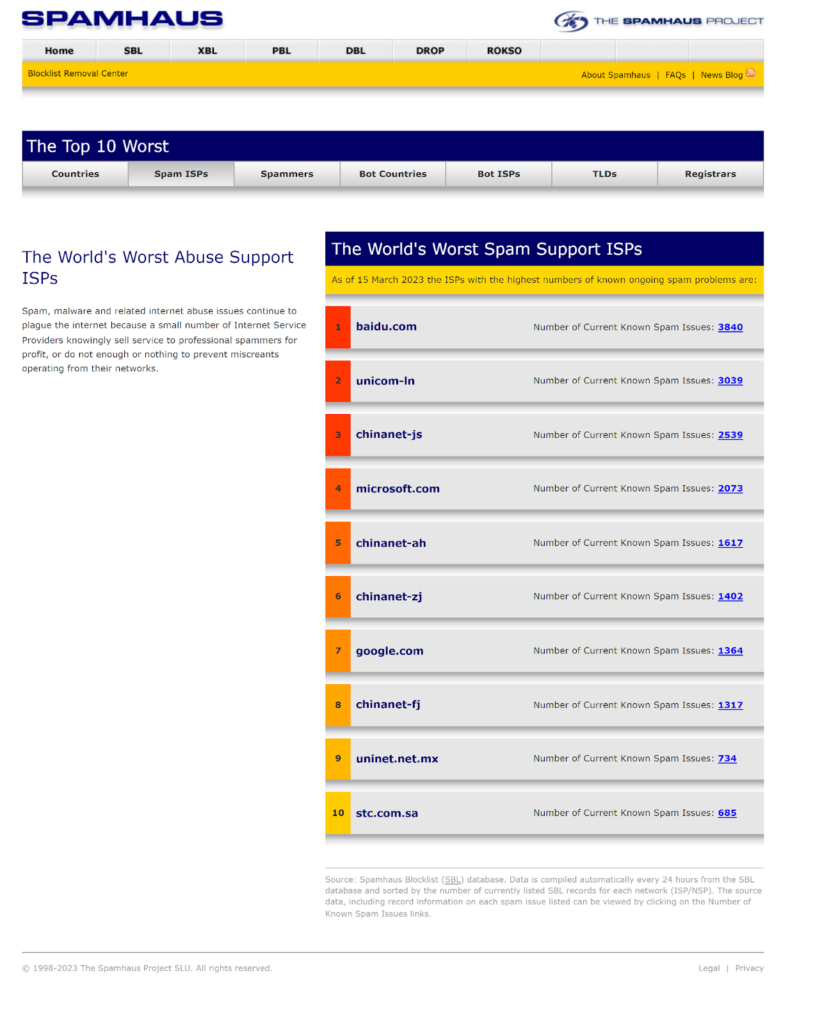
📋 What contact data integrations do your proposed delivery vendor support?
Most ESPs allow you to import your contact lists manually. Some allow scheduled updates. Still others offer real-time updating via API. A high-volume email marketing platform can support integrations from multiple data sources including your contact lists, and inventory system or ecommerce shop databases.
Why should you care about your email delivery vendor’s data integration capabilities?
Can’t you maintain and manage your contact list inside the ESP you select?
It’s true.
List management is a core function of most ESPs, enabling you to conduct email campaigns without relying on an external CRM.
Ongage’s in-platform allows users to manage 150 fields per contact. Nonetheless, we’ve found that many of our clients use external databases to manage the types and volume of information they gather about their leads and customers.
Not every organization manages and stores its contact data the same way.
Your business may choose to manually swap information between your email marketing and CRM tools, use one tool for both email marketing and contact management or use API or another integration system to share data between these different repositories.
Data integrations give your company flexibility to choose where and how it wants to store contact information.
Connecting your CRM and other data sources to your email marketing platform to facilitate data exchanges gives your cross-departmental teams deeper insights into your audience and provides your email marketing team with more data to create segments and personalize your email messages.
Other integrations can add value to your email marketing stack, too. Innovations in multi-touch attribution, persistent identities and cross-channel marketing can help small and medium businesses expand their reach and analytics capabilities.
Gathering, accessing and integrating information about subscribers is essential to meet the expectations of consumers who want brands to customize their experiences.
Choose a robust delivery vendor that is up to the task of leveraging zero- and first-party data to build one-to-many communications that deliver a one-to-one experience.
Don’t go overboard, though.
Your email marketing platform isn’t a replacement for applications with a broader remit.
Imagine a multi-level storage system that included a built-in wide-screen television, coffee maker, dehumidifier and lamp. That might be the perfect space-saving setup for some customers. But when you pack everything together in one unit, you lose flexibility and may sacrifice quality.
Likewise, an email marketing platform isn’t the best place to house all your marketing, sales and customer success functions. Look for a balance of efficiency and scope.
📋 Can the vendor handle your business’s email marketing volume–even during peak periods?
Businesses that have a large subscription list and/or send hundreds of thousands of emails (or more) each month, need a delivery partner that can handle the throughput. If your vendor doesn’t have sufficient capacity, your messages may be throttled or their send times delayed.
Also, sharing IPs with other senders can affect the IPs’ capacity to handle your email needs. For example, if everyone on your IP wants to send a blast email at 9 a.m. UTC, you all may experience delays. If you choose an ESP that doesn’t have dedicated IPs available, you’ll have to share nicely to avoid having your sending volume reduced or your account suspended.
If you are already a high-volume sender or plan to be, choose an enterprise email marketing platform that can offer you an adequate supply of dedicated IPs.
For instance, Ongage’s email marketing platform is built for businesses of all sizes. We can support and scale small to medium business’s email operations and meet the high-volume demands of enterprise level senders.
Our clients handle large-volume email marketing campaigns for single brands and multi-brand organizations. Agencies serving the needs of their SMB clients use Ongage’s multi-list options to manage each client’s email marketing program separately while leveraging an array of enterprise-level segmentation, personalization and analytics capabilities.
📋 How many IPs, domains or subdomains should your business’s email marketing operation use?
Partitioning your email program across different domains, subdomains or IPs can add to the cost and complexity of your email marketing program. But creating a controlled structure of subdomains, sender addresses and IPs also offers significant benefits.
Separating your domains and IPs enables you to:
- Maintain clear lines of separation between different customer personas, email types or senders.
- Protect your deliverability.
- Better manage sending volumes.
Organizations sometimes use domains to keep track of different categories internally. For example, all of a brand’s transactional messages may come from a customer service subdomain, or the enterprise sales division may send messages from a different domain than the marketing department.
Separating transactional, marketing and organizational emails is a common reason for domains and subdomains.
Your organization might also create separate domains to send emails to different subscriber groups, such as job seekers versus employers or home buyers versus real estate agents, or to manage different newsletters or other email subtypes.
📧 Specialty food e-tailer Nuts.com communicates with subscribers and customers using different subdomains and sender names to distinguish regular promotions, special announcements and transactional messages.
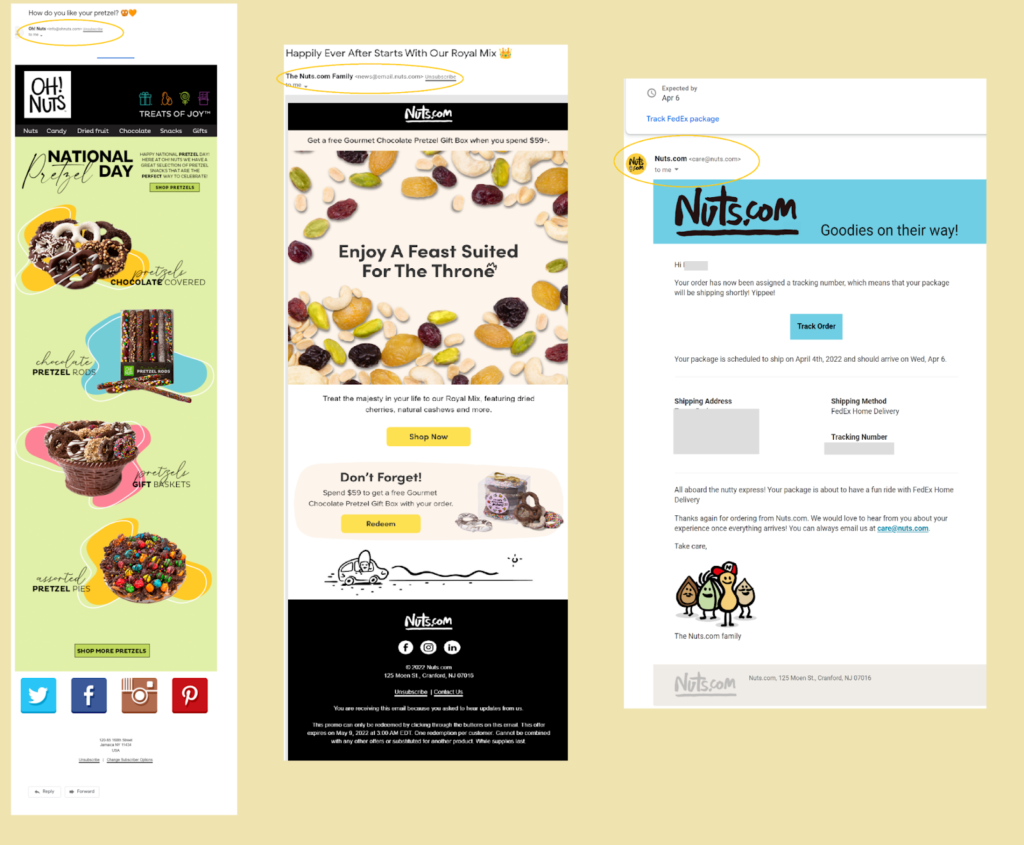
In the examples above, Nuts.com’s National Pretzel Day email came from info@ohnuts.com; its regular promotional newsletter was from news@email.nuts.com; and the transactional shipping update was sent by care@nuts.com. Each of these sending addresses is associated with a different From name visible to recipients as well.
IPs can be separated similarly. In fact, when the costs can be justified, they should be.
Your sending reputation–or how ISPs judge the trustworthiness of you as a sender–is based on all the IPs and domains associated with your organization. However, the more distant a particular domain or IP is from the sending one, the less the impact of negative behaviors will be felt.
If you send promotional emails that are marked as spam, get low engagement or otherwise harm your sender reputation, fewer of your promotional emails from that same domain and IP will reach your subscribers in the future.
If your transactional emails are sent from the same source, they may not reach your subscribers either!
There are reasons to shelter some of your IPs within your email marketing program, too.
You don’t want to risk your best-performing IP’s reputation by using them to send re-engagement or reactivation campaigns that may not reach lapsed subscribers (or get their attention). Set aside a few lower value IPs for these high-risk campaigns.
Being able to access multiple IPs can also help you distribute a high-volume email blast without overwhelming your servers–this is especially important for businesses that need to ramp up their sending for seasonal sales or communications pushes.
The IP or domain your business uses for each type of marketing email can influence the impression your messages make in the inbox, as well.
If your business manages its own transfer agents or uses a dedicated domain, your sending or From address will include your business’s domain name and extension. (“Ongage.com” is the business domain and extension in the example below.)

This From address is visible to subscribers when they hover over the Sender or From name in their inbox display and in the to/from section inside an email message’s body.
When you send your business’s emails through an ESP-provided shared IP, the From address for your email messages may reference your domain name followed by the word “via” and the ESP’s domain name and extension.

This address format discloses where the email came from and where return messages will be directed. You can add a separate Reply-To address to route email responses to an address other than your From address.
Of course, you can always change your mind and change or add to your IP and domain selections. It pays to start the way you plan to proceed though.
📋 What do the services provided by the ESP cost and how are the costs calculated?
It can cost your business nothing to begin using an ESP. Many providers offer free trials or freemium tiers for low-volume senders with few contacts.
Of course, the saying that you get what you pay for applies to ESPs. If your business is dedicated to using email marketing as a growth channel, you’ll outgrow these free providers quickly.
Paid services may charge fees based on your business’s number of contacts, volume of emails sent and the added features such as SMS sending, list validation or analytics that you select. As you probably guessed, businesses that want a dedicated IP will pay more than those willing to share.
When evaluating ESPs, consult software review sites like G2, Software Advice or GetApp that will line up each vendor’s offer for side-by-side comparisons. Also ask about the support the vendor provides and whether there are extra fees for setup assistance or technical consultations.
How to migrate your contact list to your email marketing platform when setting up your email operations
Once you’ve chosen your delivery partners and your domain and IP framework, you’re ready to create your subscription list. This is the dataset that your email marketing software will draw from when sending marketing emails. Your subscription list (or lists) usually won’t contain every contact that your business has acquired. Instead, your email subscription lists should include just those contacts relevant to your email marketing activities.
💻 Ongage clients can import their contacts following the steps in their Dashboard.
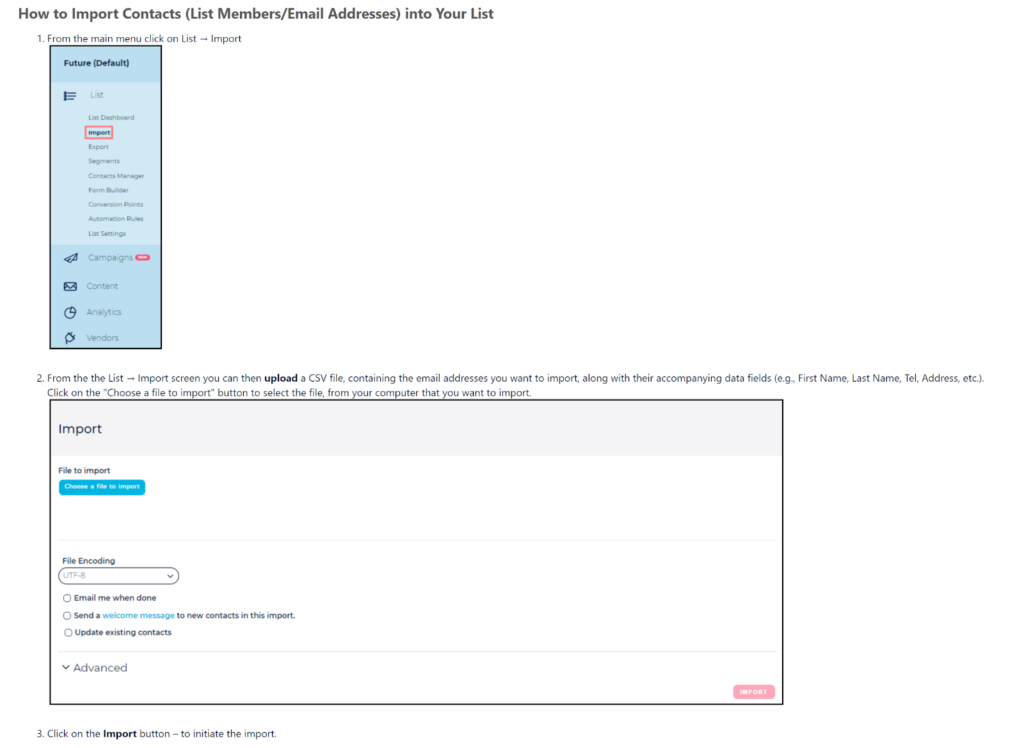
Before migrating your contacts to your ESP, you’ll need to decide:
- Which contacts will you transfer? And,
- How many lists will you create?
Choose the contacts to export to your ESP
Not every person or entity for which your business has an email address will be part of your email marketing audience. Vendors and employees probably aren’t your target market. Come up with a process to identify the contacts that you’ll communicate with through your email marketing platform and those that you won’t. Gather these contacts into a single dataset and eliminate any duplicates.
Next, create field headings in your data set that match your ESP’s field names. Follow the instruction of your email service provider to create a dataset that includes the appropriate field names (headings).
Use the sample CVS file found in the Ongage Getting Started Guide for reference when creating your field headings. Before you migrate your lists to your ESP, make sure your source and target data field headings match to avoid errors or failed transfers.
Once you standardize your field names, check your data to make sure the names and content of the fields align. Next, name any custom fields in your data set and add those names to your target list or lists. Again, you need an exact match between your source and destination files to keep your data on track.
💻 Adding your custom fields to your Ongage lists is as simple as filling in the blanks. Choose from four field types including email, string, data or numeric.

Remember the adage “measure twice, cut once” as you normalize, organize and review your contact data. It’s much easier to transfer good data from the start than to clean out bad data later.
Decide whether you’ll create one list or several
Contact datasets or groupings are called “lists” by ESPs, and you may have more than one.
Like subdomains and IPs, lists may be used to separate different sending groups, message purposes, or contact types. Using multiple lists gives you access to list-level analytics for a set of recipients and helps you maintain divisions between different organizational units when you operate several websites or offer different product lines.
💻 Each list on Ongage is treated as a fully independent data set (with a few exceptions related to suppressions or exclusions). You can assign separate default actions and other settings on a list by list basis.
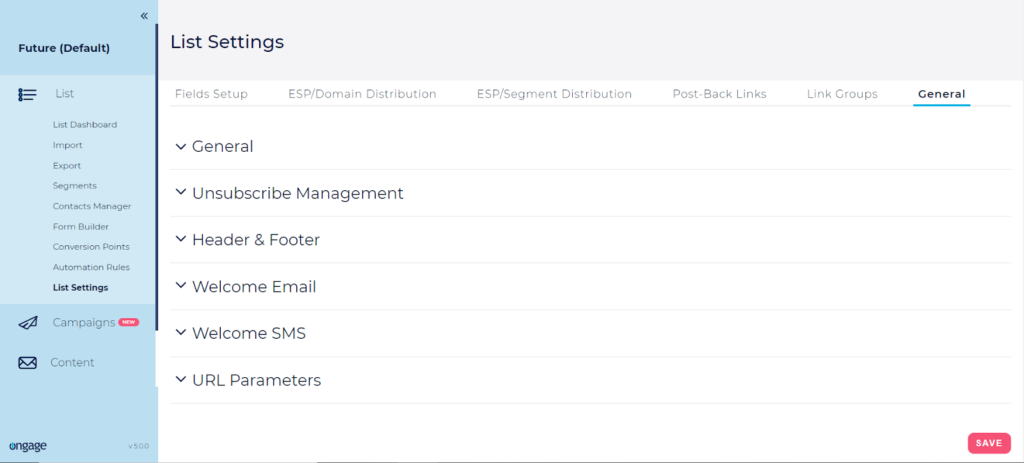
Using Ongage’s default settings, if you add a contact to more than one list, changes to that contact’s data in one list won’t affect their data in other lists. An exception to this practice is that contacts removed due to hard bounces or spam complaints are removed from all lists registered to your account.
Examples of list divisions that your small business may use to manage its email marketing program include:
- Universal or all-contacts list. All the people to whom your business has or plans to contact using your ESP.
- Transactional message-only contacts.This dataset includes customers or other contacts who have opted out of receiving marketing messages but may still receive transactional messages sent through your email marketing software.
- Global suppression or no-contact list. A global suppression list includes contacts that you will not send marketing emails to through any list within your account.
- List-level suppression lists. These lists pair with a contact list and include the email addresses that must be omitted from any marketing sends associated with that list. This type of list is useful when you offer several types of content such as promotional emails and informational updates. A subscriber may be on the suppression list (opted out) for one of your content offerings but not another.
- A pause or temporary opt-out list. Sometimes your subscribers may wish to opt-out of receiving emails related to certain holidays or take a break from receiving your emails by pausing their subscription.
- Lists related to contact attributes or business objectives. These lists can help you niche down and manage your contacts as you gain more subscribers. For example, your team may want to use lists to sort contacts by their geographic region, language, lead score, or business lines.
Which lists should you start with when setting up your small business’s email marketing program?
We recommend that businesses create at least two lists for their email marketing programs–one for active contacts and another for inactive or suppressed contacts. Keeping a list of contacts who have unsubscribed, have invalid email addresses or you want to avoid emailing prevents you from inadvertently reentering these addresses onto your active list.
Your ESP will check your chosen list segment for an email campaign against this suppression list before sending to make sure no addresses have slipped through the cracks.
If you plan to manage your transactional emails through your ESP, you may want to create another list for these recipients.
You may also want to create a separate list to house your SMS subscribers. Ongage gives you the power to deploy both SMS and email campaigns through your Ongage account. Your subscribers must opt-in separately to receive SMS notices and may opt-out of receiving emails while remaining opted-in for SMS campaigns.
⚠️ Single-channel opt-outs do not affect a contact’s other communication channel in the Ongage environment. However, our global suppression list for hard bounces and spam complaints will apply to every list that includes the contact’s email address—regardless of the messaging channel. If your SMS contact list includes the contact’s email address, then they won’t receive emails or SMS messages.
You can avoid this outcome by creating an SMS contact list that omits the users’ email addresses. Check out our SMS Campaign section in the knowledge base for more details about how to set up your dual-channel lists and campaigns using Ongage.
Clean and confirm your contact data before you import your subscription lists to your email marketing platform
Sending emails to inactive or invalid addresses can harm your domain reputation and reduce the effectiveness of your email marketing activities.
In the worst case, an email on your list may be a spam trap. These email addresses are intentionally placed where spammers are likely to find and use them. When a spam hunter receives a message sent to one of these addresses, they know the sender is engaging in bad behaviors.
An invalid email address can still cause you trouble even if it isn’t a spam trap, too.
Messages sent to invalid addresses will bounce and these hard bounces signal bad sending behavior to email clients, ISPs and third-party monitors like Spamhaus and Sender Score.
One way to ensure your list doesn’t include spam traps or invalid email addresses is to validate your contact’s email addresses before you import them or using your ESP’s validation service after import. As you gain new email subscribers, you can validate them in real time or in bulk to ensure that you don’t add bad data to your lists.
What if you start sending marketing emails to valid contacts but don’t get any engagement?
Well, there could be several reasons for this–including the possibility that your messages are landing in your contact’s spam folders instead of their inbox. But as a starting point to your investigation, you can use a reactivation campaign to see if these unengaged subscribers can be reengaged.
Determine the length of non-engagement that will designate a lapsed subscriber and create a re-engagement flow to check in. (This is one of those campaigns for which you’ll want to use a low-value IP to avoid putting your best sending assets at risk.) If you don’t get a response to your efforts, then you can add your inactive or opted-out contacts to a suppression list.
Finally, get off to a good start with your email delivery partner and avoid unpleasant surprises that can affect your deliverability before you import your email list and begin using it. Find out if your ESP permits you to import all contacts or only those who have opted in to receive marketing emails and what proof of consent the vendor requires.
Ongage permits clients to import all their contacts. That doesn’t mean it is a good idea to send marketing emails to everyone on the list. If you cannot confirm that someone opted in, consider using a confirmation campaign to gain their renewed permission.
These campaigns are similar to double opt-in email messages, except the confirmation email isn’t triggered by a new subscriber sign-up. Instead, you’ll use an opt-in confirmation email to reach contacts whose emails you’ve had for a while.
Set up your domain authentications and warm up your IPs
Sometimes before you can build a piece of furniture, you need to sand or paint the individual parts. These extra steps help ensure that the pieces fit together smoothly and your final project is a success. When you’re launching a new email operation or expanding an existing one, you need to do some prep work, too.
For new or expanding email marketing operations, these preparatory steps include ensuring that each domain and IP the business will use is properly identified and recognized as legitimate. In some instances, your ESP will handle all or part of these tasks for your business. In other cases, you’ll need to manage these steps on your own.
What do you need to do to tell the guardians of the email universe that you’ve arrived?
Authenticate your sending domains for your email marketing operations
Each time you use a new domain or IP, implement standard sender authentication protocols to ensure that your emails are allowed safe passage.
Authentication protocols enable ISPs and email clients to match the IPs transmitting your messages with your domain and confirm that your messages haven’t been altered in transit. Code confirming your authentications appears in the header of each message you send. Without proper authentication, many ISPs won’t allow your messages to pass.
To prove your credibility, you’ll need to:
- Implement the Sender Policy Framework protocol (SPF) which directs ISPs to a list of approved IPs for your domain.
💻 The headers in the image below tell the tale. One of these senders passed the SPF check, the other failed.

- Encrypt your messages using the DomainKeys Identified Mail (DKIM) protocol.
- Add a Domain Message Authentication Reporting and Conformance (DMARC) record to your DNS to enable ISPs to confirm which protocols you are using and give them instructions on what to do if they detect a problem with one of your emails.
Warm-up your domains and IPs
New senders don’t have a reputation, so ISPs and mailbox providers don’t have any way to identify whether they are good guys or bad.
That doesn’t stop ESPs from making some guesses based on a new sender’s behavior. If you use a new domain or IP in ways that trigger an email clients’ spam filters, your emails aren’t going to get very far. Telltale behaviors of a spammer include changing domains frequently, sending large volumes of messages right away and sending messages at inconsistent frequencies.
When you warm up a domain or IP, you do the opposite of these things.
Warmups involve sending gradually increasing volumes of emails from the same address consistently. It also helps if these messages are sent to engaged subscribers who will open them as that indicates your recipients don’t believe you are a spammer.
You can follow a self-designed schedule to warm up your IPs or use an automatic warm up service provided by your email marketing platform or ESP to get your new sending addresses prepped and ready to go before you use them for your marketing campaigns.
💻Warm up worry-free with Ongage’s automated processes and status reports.
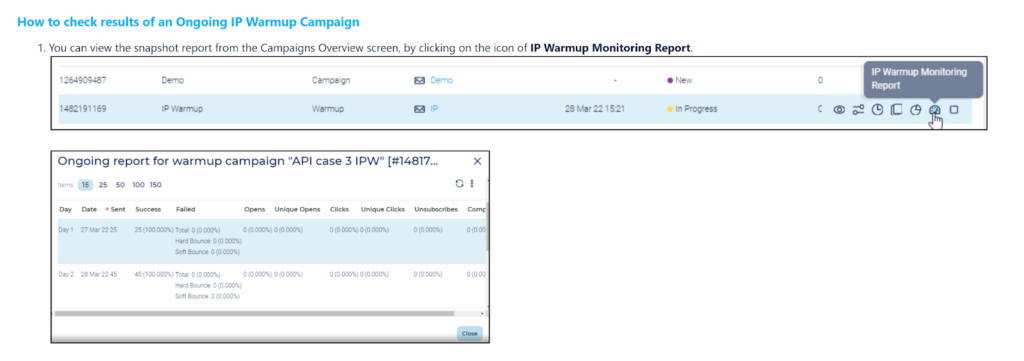
With the foundational pieces of your business’s email operations in place, you can begin segmenting your audiences, creating your email templates and automated workflows, and making decisions regarding when and from whom campaigns will be sent.
In addition, you’ll need to prepare your external tools and resources for tasks like image hosting, dynamic or interactive content, team coordination and communication, production and analytics.
Finally, your email marketing preparations won’t be complete until you develop sign-up forms, landing pages and the other digital assets outside your email campaigns with which your subscribers will interact.
I’ll explain how to complete these steps next.
Develop the non-email interfaces that support your email marketing operations
Your email marketing program doesn’t exist in a vacuum. To become fully operational, your email platform needs to receive inputs from external resources. It also needs subscribers. Your lead generation strategies may include a variety of in-person and digital methods to collect email addresses.
It’s up to you to design and execute these methods.
Build your subscriber list using digital and in-person channels with sign-up forms and other opt-in measures
Gain new subscribers for your email marketing program using online and offline touchpoints. Make it easy for people who are interested in your brand to give you their email address whether they are using a desktop computer or mobile device.
Try some of these sign-up methods to kick off your list building efforts:
- Invite online and in-store purchasers to sign-up at checkout.
- Offer a lead magnet visitors can’t refuse.
- Provide sign-up forms at your trade show and conference booths.
- Add a sign-up line to your in-person feedback forms.
- Use QR codes to make it easy for people to sign-up from anywhere without messy paperwork.
- Include subscription instructions in your email newsletters and suggest that current subscribers forward your emails to a friend.
- Place sign-up forms on your social media pages, on your website’s contact page and in your website’s header or footer.
- Offer incentives for new subscribers to share their email address.
- Gamify your sign-up process with contests or interactive content.
- Add pop-up subscription invitations triggered by users’ on-site behavior.
💻 Pact clothing store employs an always there sign-up in its website footer plus strategically deployed pop-ups to capture new subscribers.
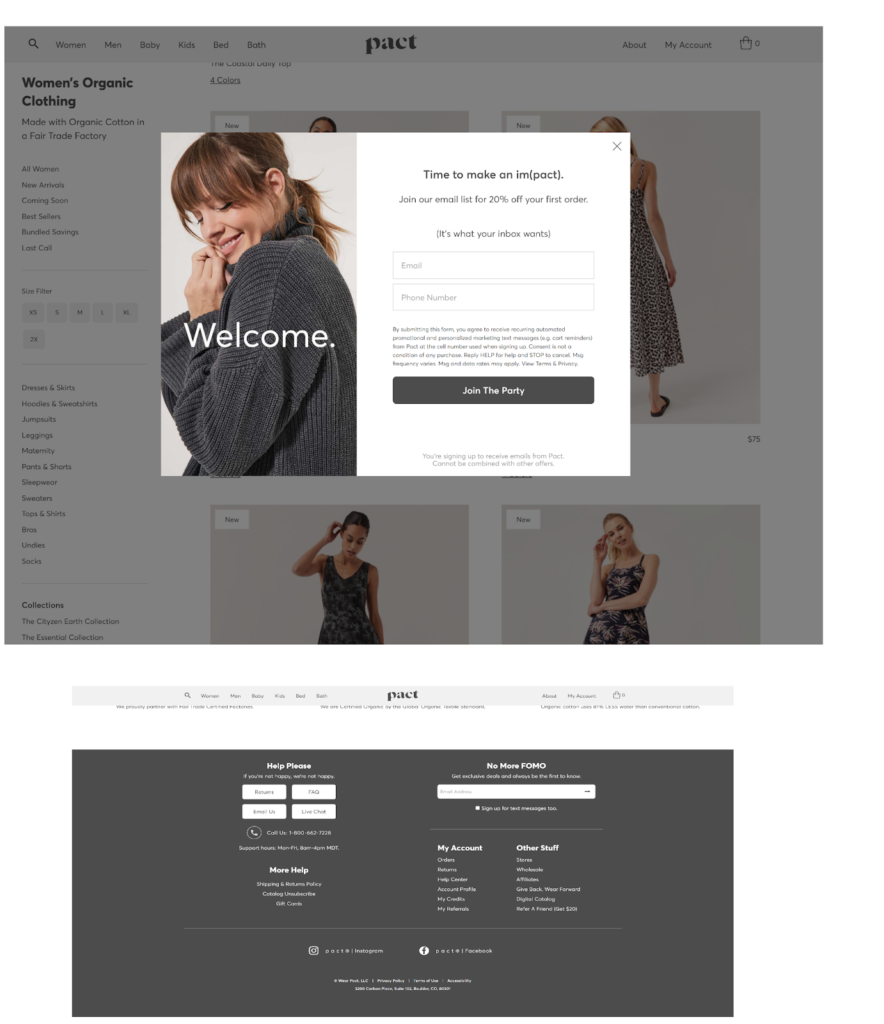
💻 Hungryroot offers an incentive and interactive content to catch exiting website visitors’ attention.
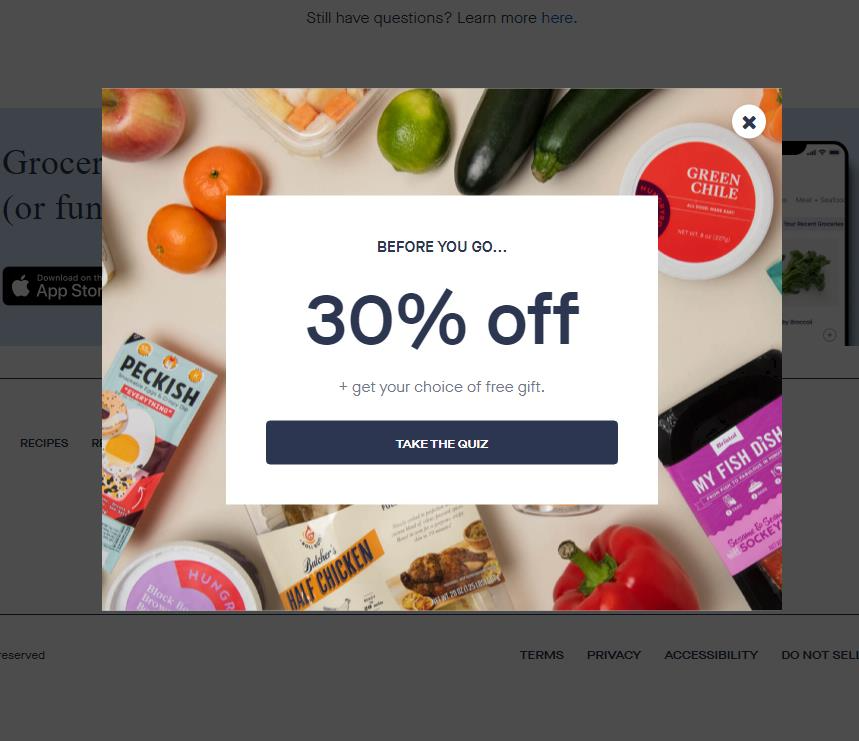
Use Ongage’s form builder to create subscription forms for your website in flash. Or use one of many third-party tools to build static web forms, pop-ups and other subscription devices.
Use transparent, permission-based methods to ensure your subscription list is filled with people who are interested in your business
As you gather these new contacts, make sure you are also getting their consent to receive marketing messages from your organization. Use affirmative consent methods such as checkboxes or other acknowledgments and keep a record of when and how the subscriber gave permission.
For extra confidence about your subscribers’ intentions, send confirmation or double opt-in autoresponders to your new subscribers.
Double opt-in systems may reduce your initial subscription numbers, because only email recipients who confirm their subscription are added to your active list. However, this method of confirmation also ensures that your list only contains addresses that are real and active.
Add an unsubscribe landing page and a preference center to your business’s website
Must all good things come to an end? Well, maybe not all the time. But some subscription churn is inevitable. When a subscriber isn’t that into you, don’t make it hard for them to say goodbye. Providing an unsubscribe option is the right thing to do, and it’s required by law in most jurisdictions.
Your email messages should each provide a link to an unsubscribe page–that means you need to have a page to go with that link.
Your ESP may provide a generic page that acknowledges your contact’s unsubscribe request. But you can leave a better impression by creating an unsubscribe landing page that says “Farewell” in your brand’s voice.
When someone wants to unsubscribe from your email list, don’t obstruct their efforts by hiding your unsubscribe link or making them complete multiple steps. Do, however, use other methods to encourage them to stick around.
You might be able to avoid saying goodbye altogether by creating a preference center that puts your subscribers in control of their interactions with your brand.
5 ways to redirect or regain a list member who has clicked your unsubscribe link
- Include a preference center section or links to a preference center page on your unsubscribe confirmation page. To build a preference center that transfers data directly to your Ongage database with no API coding download this email preference center file and follow the setup instructions in our knowledge base.
- Add copy on your unsubscribe landing page that tells departing contacts how to re-subscribe if they change their mind. Include re-subscribe CTA, too!
- Suggest other ways to connect with your brand, such as following you on social media or subscribing to texts. It’s an omnichannel world. Make sure you aren’t missing out on a chance to stay connected.
- Ask people who unsubscribe for feedback using a form or link to a survey on your unsubscribe landing page. Asking for feedback from your unsatisfied audience members is a great way to gain valuable knowledge about what you could do better.
- Offer unsubscribers an option to pause their subscription or reduce the number of emails they receive from your emails. People sometimes unsubscribe from email lists because they don’t have any other option to reduce the traffic in their inboxes. Be the brand that understands and puts your subscribers in control.
💻 Online and bricks and mortar retailer Nordstrom asks subscribers to confirm their intentions (and an option to change their mind) on its unsubscribe landing page.
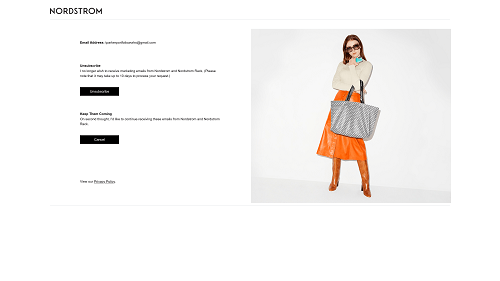
📧 Opensky enables subscribers to opt-out using an unsubscribe header plus a link in the brand’s email messages.
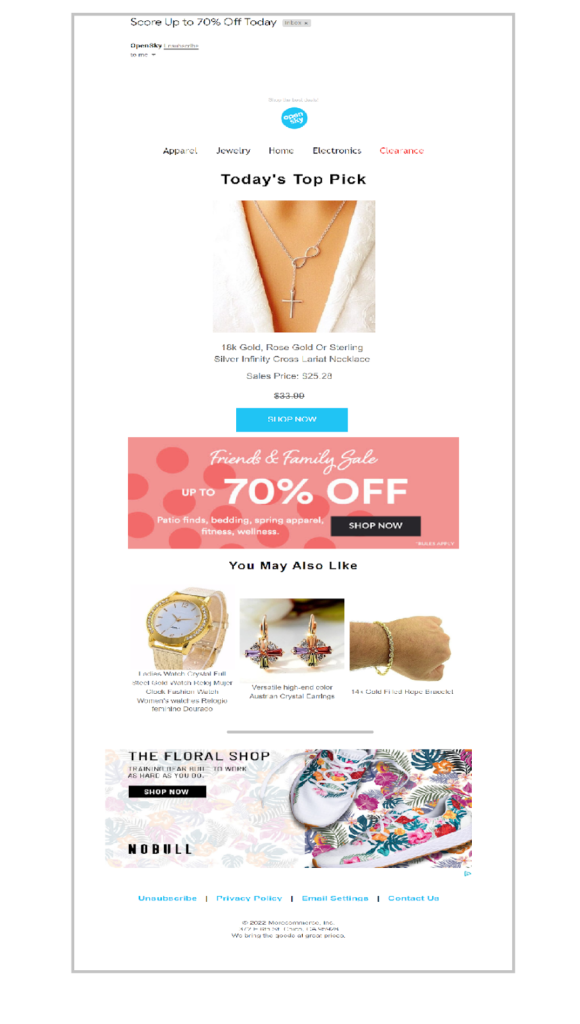
💻 The online everything store provides a separate link to a detailed preference center, giving its subscribers plenty of options for staying in touch.

How to set up your small business’s email marketing segmentation to maximize your program’s performance
The more focused your email campaigns are, the better your outcomes will be.
But sending focused, relevant messages to lists that may include thousands or tens of thousands of unique individuals can get a little tricky. Not everyone in your audience has the same motivations for joining your subscriber list, nor are they at the same stage in their buyer’s journey.
Reaching the right person, with the right message at the right time significantly increases your chances of convincing them to act. List segmentation is one of the tools you’ll use to achieve this ideal.
Segmentation is a data grouping process performed using your email marketing software. You create segments by defining the criteria for each group. Then the software automatically places the contacts on a list into each of the segments for which they qualify. Once a segment is defined, you can create an email campaign made for a single segment or use the customization strategies described later in this article to create a campaign that appeals to several segments.
Unlike lists that require pre assignments, segmentation is fluid.
A contact whose characteristics or attributes change may be moved from one segment to another automatically. For instance, a new subscriber may begin their relationship with your brand in the “new contact, non-purchaser” segment. Once that subscriber makes their first purchase, they’ll fall out of the “new contact, non-purchaser” and into the “first-time buyer” segment.
This allows you to design campaigns and designate segments well in advance of when you schedule an email to be sent without worrying that your email won’t be relevant when it arrives. (Your freshly minted, first-time buyer won’t continue to receive “Make your first purchase” email messages.)
What are some of your list segmentation choices?
You can build a simple audience segment based on one attribute or develop hyper-targeted segments that combine several attributes. For example, your marketing team might decide to send a request for feedback campaign to a retail audience segment comprising customers that have made a purchase within the last 30 days.
If their objective was to get feedback and boost third-party reviews for specific locations, they might instead design a narrow segment made up of customers that made a purchase from a specific physical store within the last 30 days.
💻 This Ongage example illustrates how to use multiple criteria to create a segment of recently added subscribers who have not opened any emails from the sender.
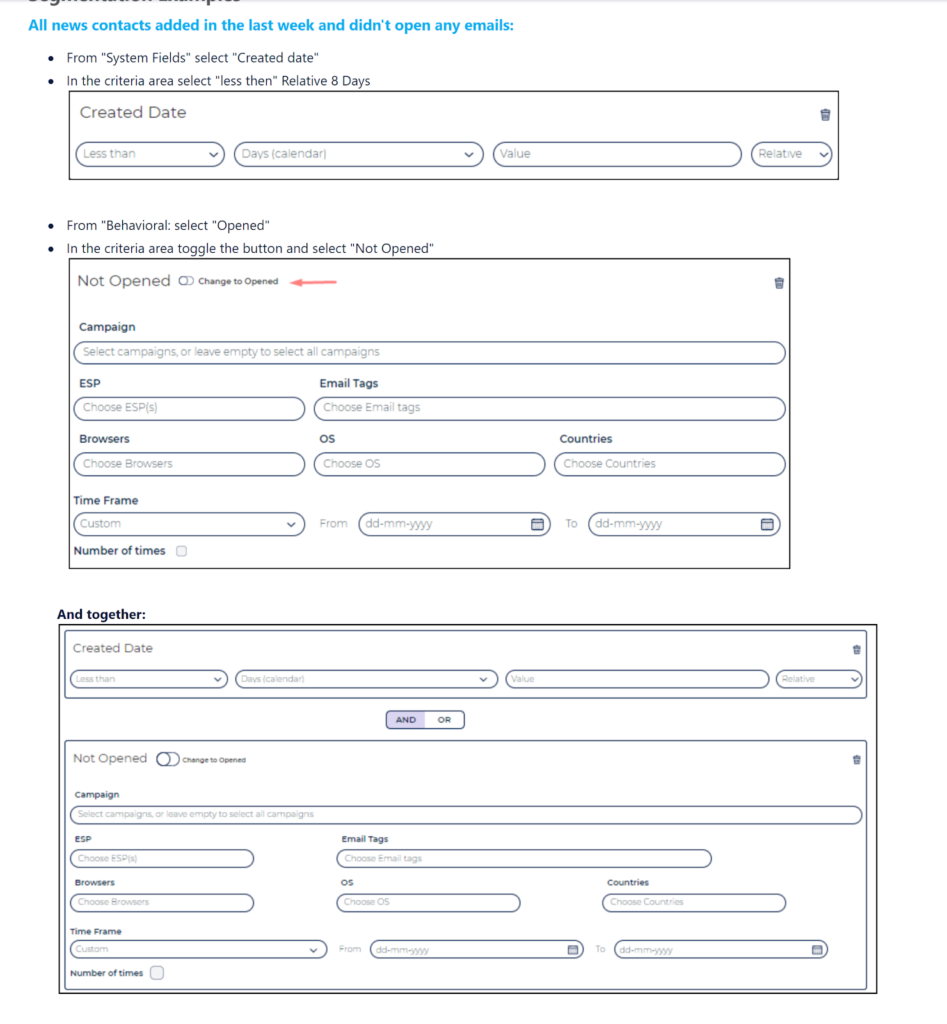
Segments may be based on a subscriber’s demographic or psychographic characteristics, specific information they’ve shared with your brand, behavioral data you’ve gained through their interactions with your brand or other factors.
Data such as when a person first became a subscriber, how many emails they’ve received from you during a specific interval or similar first-party observational or tracking data is stored in system fields that you can also use to create segments.
The more attributes you use to develop a single segment, the smaller your audience segment is likely to be. Narrowing your audience size in this way increases the chances that your message will resonate with more of the recipients.
👀 Check out our comprehensive guide to list management to learn more about contact data, segmentation and how to optimize your email lists.
How to set up your small business’s email marketing content production process for efficiency and high performance
Finally, with all the other pieces in place, it’s time to develop efficient processes to develop your email marketing program’s critical deliverables–the emails!
Leverage modular email construction strategies and automation to streamline your production processes and deliver consistent, on-brand communications.
How?
If you don’t have a style guide and content asset repository for your organization, start with those. Make sure anyone involved with creating your marketing emails whether they are in-house staff or an email marketing agency team member uses the correct logos, contact information and other data and graphics when creating your email templates.
Email templates?
Oh yeah. You don’t want to build every single marketing email starting from a blank page. That’s not scalable. Instead, start your email marketing program with a collection of templates that you can modify as needed.
Streamline your small business’s email marketing operations by developing a bank of email templates
Most email marketing programs rely heavily on two main types of email campaigns: bulk emails sent to everyone on an entire list or list segment simultaneously and drip or triggered campaigns that are sent to different recipients at different times.
📧 Templates like the one Inovalon uses for its email webinar invitations can speed up production and help you maintain consistency across your campaigns.

Both of these email campaign types can be prepared in advance and use common components.
Build email templates that incorporate your brand’s preferred styles and formats. Your base template should include an email footer with all the required and desired information such as your contact information, unsubscribe links and social media icons.
Using this base, you can develop templates for promotional blasts, newsletters and other types of messages by adding a standard or customized header and different panels or sections in the body of the email template.
There are many tools to help you create full email templates and individual components, such as GIFs or interactive elements. Most of the elements that businesses include in their email templates can be added using a WYSIWYG email editor. Unless you plan to send only plain text emails (and you probably don’t), these editors will save your template as HTML code suitable for email sending.
Store your templates in your email marketing platform or your external content management system and be sure to add template content reviews to your email program’s audit schedule. Changes in your brand’s styles, communications strategy, external regulations or industry best practices can cause your templates to go out of style. Regular reviews keep your templates from getting stale.
Find instructions for storing your templates in Ongage in the Template and Image Library section of the knowledge base.
Templates give you a fast start to building emails and keeps your team moving at the speed of commerce, but what about the unique content you want to add to each message? There are some ways to streamline that part of the process, too. (Hint: It involves automation.)
Select and connect your image repository to your email marketing platform
Content such as images or other graphic elements in an email may be embedded in the email as part of its data file or downloaded (a.k.a. fetched) when the email is delivered or opened. Image fetching reduces file sizes and can speed up an email message’s download time. But image fetching requires that those images be stored somewhere.
That means you’ll need an image library.
Ongage users can choose to store their images on the platform or in another location. The main factors to consider when choosing where to store email images for download are storage costs and capacity, and retrieval speeds.
If your storage solution doesn’t deliver your images quickly, your email subscribers might not get the best experience when opening your emails. (Some email clients pre-fetch images, which can remedy this problem.)
You’ll probably be charged a fee per download when storing images on a third-party site, so consider your expected sending volume when assessing the benefits of each solution.
Brands that send lots of emails at once (mass sends) or emails containing many images need a service that can handle many draws on the system at once.
Automate the insertion of dynamic content into your emails for one-to-many customized marketing emails
Static content isn’t your small business’s only email marketing option. You can add HTML code to your emails that inserts custom data into each message.The results are one-to-many messages that deliver a singular experience for each subscriber. How does that work?
Create customized messages by adding dynamic fields (merge tags) and blocks to your email templates. These fields and blocks serve as placeholders for data and allow you to insert individualized data into your messages.
For example, if your template includes a dynamic field for the subscriber’s first name, their name will appear in the message sent to their email address. A dynamic content block can insert an entire section of job listings for a particular location and profession, or a time-based list of upcoming events.
📧 Dynamic secrets revealed. Yarn.com delivers new content every time by combining static blocks (visible in the browser view) with dynamic content that references each time the subscriber opens the email.
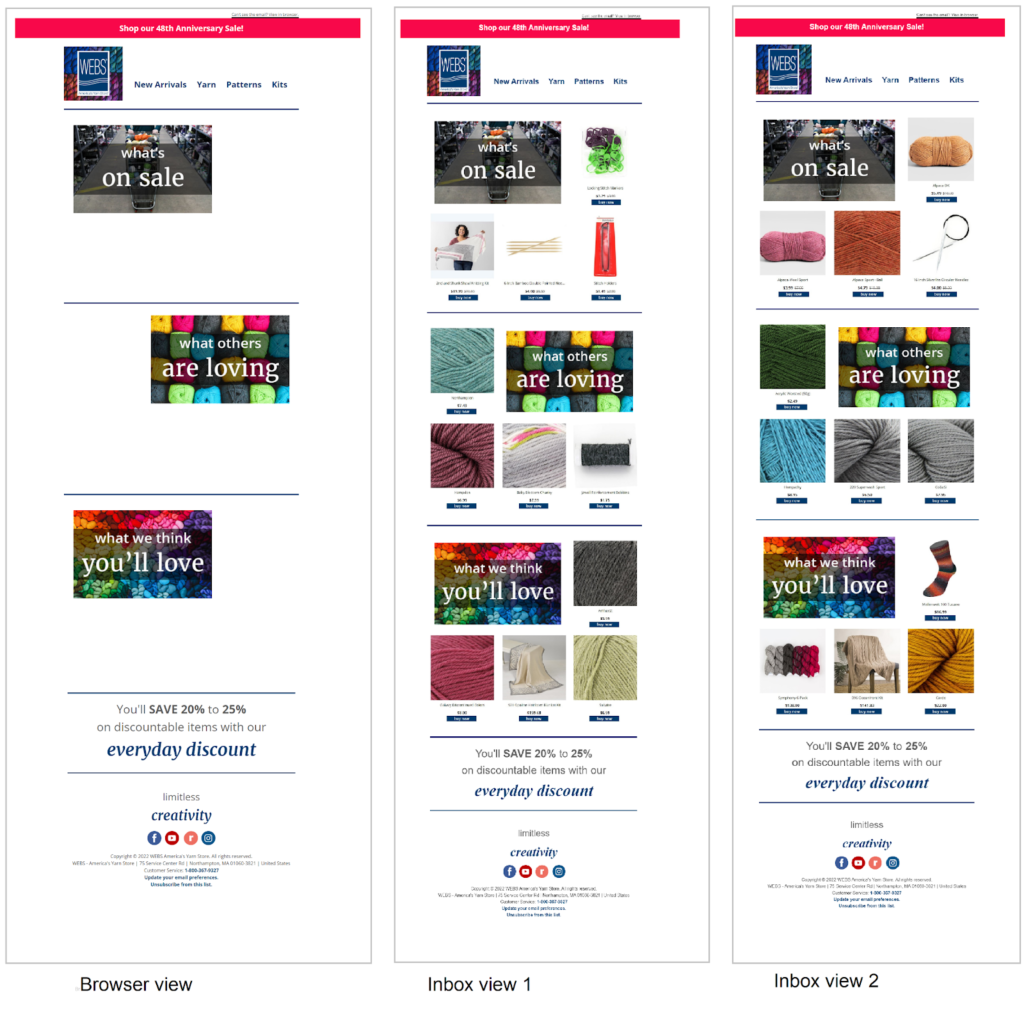
Ongage empowers brands to make every message unique by adding dynamic elements drawn from contact list fields or through third-party integrations, including API and RSS feeds.
Add automatic, triggered emails and drip campaigns to your email marketing system
One of the greatest benefits of using an email marketing platform for your small or medium business’s email marketing program is access to automation.
Email marketing platforms are built to handle high-volume sends and optimize performance and efficiency through automation. To leverage this power for your business, you can set drip campaigns, regularly scheduled newsletters and other automated email messages that are sent when you want them to be and include customized content.
Triggered campaigns are an especially powerful tool that can not only capture your subscriber’s attention at the moment of want or need but also surprise and delight them by delivering relevant, useful content.
An automated email or email flow doesn’t arrive in every subscriber’s inbox at the same time like a bulk send or newsletter. Instead, they are sent when your email marketing software detects the trigger you’ve defined.
These timely emails may be activated by your subscriber’s behavior on your website or their interactions with your emails. You can also activate a campaign based on the passage of time or other parameters.
Which automated emails should be at the top of your to-do list when setting up your email marketing operations?
Among the first campaigns you should create is a welcome sequence triggered by a new subscriber sign-up. These campaigns get your subscriber-to-brand relationship off to a good start by showing new contacts that you’re paying attention.
Equally as important as welcoming new subscribers is welcoming new customers.
Build an automated thank you and onboarding series that shows new customers your appreciation and ensures a positive experience with your product or service. Supporting your customers after their purchase increases customer loyalty and reduces customer attrition rates–enabling you to grow your business faster.
Next up, create recovery emails to reduce the number of prospects who get away. Recovery emails employ nurture and win back strategies to bring people back into your funnel or prevent them from leaving.
The most common types of recovery emails are abandoned cart or abandoned checkout messages that attempt to convince a subscriber to finish making a purchase. Other conversion points that are ripe for recovery campaigns include browse and form abandonment. Examine your customer journey map to identify the key moments when not losing someone’s interest will have the greatest impact on your revenue and build automated recovery campaigns to reach the subscriber in those moments.
Finally, add a re-engagement or reactivation campaign to your inventory to help you manage your list growth and keep it healthy.
Unengaged subscribers can weigh down your lists and reduce your deliverability. Create an automated reactivation flow and sunsetting policy to give these subscribers a final check-in.
Set your response criteria and automatically move subscribers who don’t respond in time to your inactive list.
📧 Behavior-triggered abandoned cart campaigns are a revenue winner for ecommerce brands. This one from Schoolyard Snacks includes a promo code and a countdown timer to persuade on-the-fence subscribers to click “buy now.”
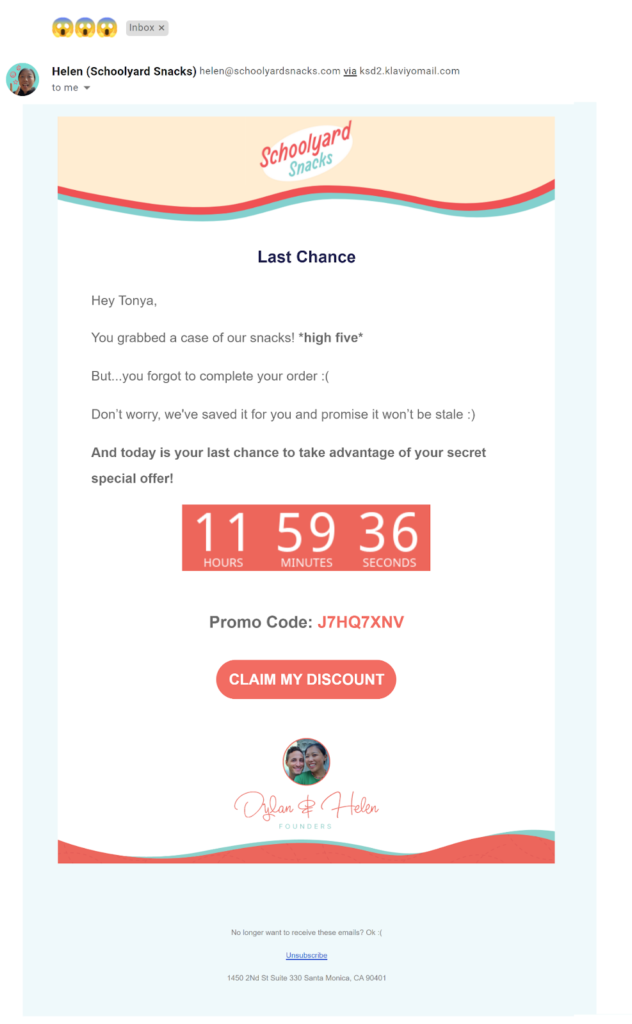
Combining automation with data to build customizable drip campaigns at speed can transform your email marketing program to a high-performance revenue engine.
Set a course for data-driven growth with email marketing testing and analytics
Just like a piece of furniture can lose its value and functionality if you add too many embellishments, it’s possible to overload your email marketing program with too many unnecessary features. But, data analytics isn’t one of those.
Effective email marketing programs use data to define success and plot new paths. Set up your data gathering and analysis capabilities to ensure you’re investing in the right strategies at the right time to maximize the impact of your email marketing operations on your small business’s growth and revenue.
- Include policies for when, how and how often to conduct A/B testing of your email campaigns in your email program’s plan.
- Create a pre-launch checklist that details each of the tests and reviews your team should complete for each campaign.
- Use preview tools to make sure your templates and individual campaigns perform as expected.
- Keep an eye on your sender reputation by registering with various ISPs feedback loops email client postmaster tools, including register with Google Postmaster Tools, Verizon’s Postmaster Tools and Microsoft’s Smart Network Data Service (SNDS).
- Connect your email marketing platform with your other performance and tracking tools to gain a holistic view of your marketing program’s performance.
- Choose your campaign and program level KPIs and define your benchmarks. Ongage offers its clients multiple ways to gather and analyze data and produce detailed, actionable reports. Dig into the details in our Analytics wiki.
With the right tools and materials, you can build a high-quality email marketing operation that can grow with your business.
What comes next?
Follow the steps in our Email Marketing Optimization Guide to fine-tune your small business’s email operations and check out these strategies to improve your engagement and deliverability metrics to maintain your program’s growth!

















